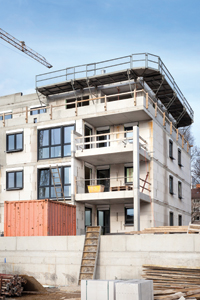
|
| Photo credit: ©istockphoto.com/ollo |
With the early 2013 economy trending little better than last year’s state of suspended animation, the American consumer, comprising close to 70% of the nation’s $15.6 trillion gross domestic product, has maintained a sense of justifiable caution.
In solidifying a savings rate that averaged 3+% in 2013, what seemed to be a traumatic post 2008-10 Great Recession reaction has settled into a long-term conservative new habit. It has transformed a debt-laden populace into a more prudent body, reflecting a growing antipathy toward loading on a new round of future debts. Even with interest rates at an all-time low, wage earners are realizing that income is getting harder to come by, especially if they are lucky enough to have a relatively secure full-time job.
This concern for future debt burdens also has transcended into Americans’ 60-year enchantment with owning a home. The post-World War II love affair with homeownership, which resulted in construction of multimillion new homes, was further exacerbated by the acquired practice of “flipping.” This combined the benefits of upgrading new home purchases every seven to 10 years with a tidy profit, as housing prices seemed to be in an unswerving upward climb.
The fever line came to a crashing halt with the mid-2008 financial depression. Subsequent foreclosures, short sales or sheer abandonment yielded the bitter fruit of unrequited asset building, which turned into bankruptcy in many cases.
Although optimistic observers point to a steady increase in new building permits and housing starts, published statistics make no differentiation between utilization for private ownership or leasing. The latest surveys indicate that a substantial percentage of current rising home sales are headed for rental or even long-term lease units. With the uncertainty as to what the economic future holds for price stability, it’s almost a sure bet that an increasing percentage of new single-family home construction or apartment buildings in metropolitan areas are heading for long-term leases.
Furthermore, this projection into an uncertain economic future has shifted America’s middle-class investments into the liquidity of fixed-income purchases, as well as an even greater move toward dividend-paying stocks. This trend, which boosted the stock market’s Dow Jones Industrial Average by 11% in the first quarter, was abetted by two additional factors:
- As the second quarter gained its footing, the continuation of peak prices and minimal income from fixed-income vehicles is now translating into a greater shift into equities. Especially so are those with high valuations, coupled with dividends greater than those available from bonds.
- The U.S. equity markets’ trend has found additional patrons in worldwide funds seeking stability and rising returns in under-valued but stable corporate stocks. With developing nations’ returns suffering from a wave of uncertainty that has enveloped that sector’s liquid investment, the mammoth U.S. financial market is increasingly appreciated as both the most secure as well as the most promising when it comes to bottom-line returns. Based on the current trend, this should provide an additional thrust into the mammoth U.S. equity markets, resulting in record returns going forward.
Housing comeback questions
One would think a return to the pre-Great Recession days — featuring a new outburst of residential construction and skyrocketing home prices endemic to that time period — is just around the corner, according to some recent media hype.
Although various research groups agree that a steady improvement is now in the works, this is by no means a return to the 50-year housing expansion that made residential construction a keystone of America’s world-leading economy and a central long-term investment focus for most middle-class American families.
As the revived U.S. housing market has been exhibiting signs of steady improvement, it is becoming increasingly clear that the current residential comeback has a distinctly different basis, separating it from its residential forebears. These differences include the following:
• Much of the current revival is related to the replenishment of single-family home inventory that was undercut by rapid foreclosures or short sales. These circumstances left the United States with severe housing shortages in some regions but a continuing glut in others. The current situation has had a reasonable pricing upgrade but no bubble effect anywhere.
• Although the U.S. population has increased substantially during the past five years, ownership demand continues to be soft, despite the pressure resulting from 5 million to 10 million additional homeowners or rental occupants during that time period.
As I discussed earlier, much of the additional building occupancy today is based on potential long-term leasing or rentals. Much of this is due to a residual high unemployment that makes the average middle-class working family look at owning a home today as a liability as well as an asset. This is especially true if better job availability requires distress selling.
While building permits and subsequent housing starts had fallen to as little as 500,000 in the spring of 2009, they still were below the 700,000 mark a year ago. They have risen to the 900,000 level recently, but this is still way below the 1.65 million starts a year reached at the turn of the millennium. And that occurred with a population 10% below today’s level.
Although the stock prices of home builders such as D.R. Horton, Pulte Group and Toll Brothers have more than doubled from their recession-level low points, they may have overshot the mark with an average of 24 times last year’s price/earnings ratio.
In summation, the combination of record-low mortgages for those investing in residential homes for subsequent rental and those still buying for long-term ownership will keep housing at a reasonable level, but without anywhere near the boom previously enjoyed.
Part-time employment rising
As America’s grinding unemployment struggles to overcome both limited job availability as well as a quickening influx into the nation’s slow-growing employment sector, part-time jobs and subcontracted production support are becoming a long-term attempt at a joblessness solution. This evolving state of affairs is abetted by federal government policies that are influencing business owners and managers to look for ways to satisfy customer demand, while not having to face the incubus of wage and benefit contracts, which are sure to become increasingly cumbersome in the months and years ahead.
As the overall U.S. economy attempts to keep the national gross domestic product above the breakeven status, privately owned businesses, which make up 80% of the nation’s workforce, are utilizing their entrepreneurial skills to inch ahead in a “maintenance, replacement and productivity” business climate.
Part-time or supplemental job additions today are looked at as a temporary expedient. This approach, however, may well turn out to be a permanent fixture, even as the United States, the world’s leading overall economic superstructure, forges slowly ahead.
My conversations with many independent business owners have supported the part-time employment thesis as a long-term business growth approach, which will be supported by several conditions:
- Obamacare and Frank/Dodd financial over-regulations have come up constantly in my dialogue with independent manufacturers, distributors, contractors, retailers and executives of professional organizations. Although attributing the onerous burdens of so-called “affordable health care” and stagnating restrictions to the current administration, these entrepreneurial business tycoons don’t expect the current perceived anti-private ownership hostility to get better in the future.
- Fortunately, they are generally optimistic about business growth opportunities in the long term, but they feel that they are being left to their own devices, which include improved productivity through upgraded technology on the shop floor and the back offices.
- What at one time was thought to need the hands-on employment of large numbers for production and internal support jobs has changed. The belief now is that the most effective businesses are those that can get the job done with the fewest number of employees to increase the margin between cost and selling price.
- Business owners, whether goods-producing or service-oriented, have little illusion about a reversal of today’s federal and state government intrusion under the guise of “climatological purity” and consumer protection. Not one business person with whom I discussed these issues believes that government will return to President Calvin Coolidge’s adage, “The business of America is business.”
The hypocrisy of avoiding passage of the XL oil pipeline and the antipathy toward America’s fossil fuels (coal, oil and natural gas) came in for severe criticism. Such obvious deterrents to business growth have gone a long way toward independent owners keeping their guard up, higher than ever.



